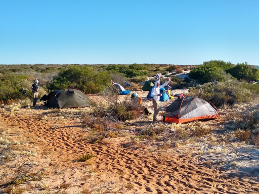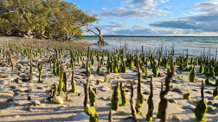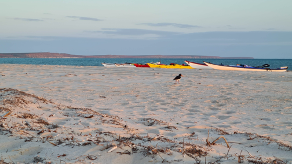Trip Report by Sean Sinclair
September 2021
When I saw the Shark Bay expedition being advertised, I could not wait to get on board. The opportunity to do an expedition around Cape Peron does not come by that often. So when Pel and Bruce confirmed I would be able to join in, I was quite excited. So I cut short an already planned camping trip by a day or two and got myself organised. Dry bags, light weight hiking equipment, meal plan and gear. I had a quick dry run of packing it all in the kayak to make sure it would fit, and deciding what went where.
I left home Saturday and met Pel in Northampton. We had only met briefly once before, and it was a good opportunity to get to know each other over a beer and a meal. The next day we went on to Denham, where we scouted out the Monkey Mia landing and car park situation. We then checked into the chalet at Denham Seaside and got our kit in order as the rest of team started to arrive. Dylan, Austen and then Kim and Bruce. Being a south of river paddler, I had not met nor paddled with any of these guys before. So after a few how-do-you-dos and what do-you-dos, we got down to business. It was decided we would start the next morning, with prevailing winds being a big factor in that decision.
The first day was a bit of a late start as we had to organise the cars to the take out point, which was a 50 km round trip. It was around 10 before we got under way. The wind was in our favour, but the tide was going out literally before our eyes. The witty banter between comrades soon went quiet as the crew focussed on packing their gear. We needed to carry everything. Food, water and equipment for 6 days. 5 planned and 1 spare if needed. This meant about 4 litres of water per day and about a kilo of food (when reconstituted). All up around 30kgs of consumables plus another 15kgs of camping and safety equipment. Therefore fitting it all in required careful thought for placement and accessibility.
I had no idea regarding the extent of the shallows around this cape. I had not even given it any consideration. Low tides would prove to be almost as big an issue as wind. With the tide dropping, it flows across the shallows, and they extend to the horizon. The more we committed to paddling inshore, the more we ran the risk of running out of water if we took too long.


For the most part of the first day, we paddled through water that varied in depth from 1 meter to as little as 20cm. We spent a lot of time manoeuvring to find deeper parts. We had a strengthening breeze at our backs, and were making excellent progress. We beached for a quick lunch break, displacing many small sharks in the shallows, before heading on to Big Lagoon for our first camp.
Big Lagoon and its turquoise blue entrance is quite spectacular. After drifting over the last few hundred metres of shallow rocky reef, the crystal clear waters and initially grassless sandy bottom were a sight to behold. A few Rays and Turtles were spotted quite close by as the water way drew us into the lagoon where we sought a suitable camp site for our first night. Ample bird life was also to be seen resting on the tidal sand bars. During the latter part of our day, and inside Big Lagoon, we witnessed on many occasions fish leaping out of the water. This activity continued right in front of our camp site. With the sun setting behind us as we looked out over the waters, brilliant flashes of silver kept on popping up out of nowhere. Some of these fish where a good 30-40cm long, so goodness knows what was chasing them.


Day Two
and up early for a big day to get right up the coast. If wind and tides were in our favour, we would try to make it to Bottle Bay camp site. This was the furthest of 4 options being approximately 32kms from Big Lagoon. Kim was our leader for the day. Rounding the red sandy headland we pushed north by northwest. Very soon it was apparent that our luck was in, and the wind was pushing us along quite nicely, and we were still in front of the falling tide. We paddled across the shallows spotting many of the usual sharks and rays. We tried to pick a beach for lunch but locations were not easy to find. So we ended up just pulling up on very slightly submerged sand bar where small sharks were scouring the sandy bottom in around 10 cm of water. Whilst we ate we were treated to a swim by of a magnificent shovelnose ray. It was about 1.5m long with its easily identifiable triple fin tail, diamond shaped body and eyes on top of its flat head. In other parts, similar species are often called guitar fish. Kim has a photo I think.
After about 20km of paddling over the shallows, we rounded Cape Lesueur and moved over some deeper open water. We revelled in the conditions, finally being able to open up the shoulders and run with some of the wind waves rolling through with the breeze. After a brief discussion on suitability of using the public camp ground we broke camp around 2pm. There was a little bit of kayak hauling required to get them nearer to camp, and out of the way of beach fisherman. The long drops were suitably utilised for their intended purpose, no worries there. Bruce and Pel arrived shortly after, after an adventurous day performing 4WD rescues, amongst other things

Day Three
would see us rounding Cape Peron early and then start our paddle south towards Herald Bight. The wind was now blowing from the west as the weather was starting to change. This was somewhat on our shoulder and not too much of a hindrance as we progressed south. This section was highlighted by vibrant red bluffs plunging down to white sandy beaches or turquoise seas. Many of these parts are not easily accessible. The scenery speaks of time, with oxidising and eroding on its surfaces happening every season. A sea kayak is the ultimate way to really get to see this.

Day 3 would also bear witness to ‘The Mishap’. Dylan had packed his ‘mocha pot’ so he could enjoy fresh brewed coffee along the way. We stopped for morning tea break and he quickly unpacked it and his gas stove to get a brew going. We could could hear it getting all steamed up and Dylan declaring it done, moving in to grab and pour, only to bump it off the stove and tip its wonderfully aromatic contents onto the sand. He said absolutely nothing, just cleaned up, packed up and paddled off. He did confess later to there being an absolute rage happening on the inside.

We made it to Herald Bight by lunch time. After a short discussion between mouthfuls, we decided that we would take advantage of the westerly wind and continue on east to camp on a small promontory that projected north from headland. This part featured white sands and mangroves seemingly unspoilt by people. The 5km paddle straight across the bay provided some large turtle sightings and our first Dugong sighting. I think Dylan spotted it first being almost directly over it. The Dugong swam straight towards Kims boat, before realising he was there. It then did a terrific turn about, flicking its tail in the air, and splashing Kim. What a great encounter for them. We were really quite happy with our decision to camp at this spot, and we were treated to a spectacular sunset as some clouds rolled in. There was some rain during the night as the tip of a cold front passed through.


Day Four
Patchy skies greeted us as the sun broke first light, illuminating the tent walls, highlighting the beads of water on the fly cover. It was going to be a wet pack up for sure. As we paddled across the now flooded sand bar that was the absolute extension of promontory, there was a massive congregation of mostly Pied Cormorants on a sand island just in front of us. Kim asked us to pause so he could make a video of them. They were guaranteed to take flight as we drew near and he wished to capture it. There were literally thousands of birds all gathered, and as if on cue they all started to take flight. It was a mass exodus, with a cacophony of sound like you just can’t imagine. The beating of wings and pattering of webbed feet wildly kicking to assist with flight, in an orderly fashion of who’s first, hundreds at a time. You need to see Kim’s video to believe it. There were so many taking to the sky it was turning black as though there were swarms of these birds. Most birds relax their sphincter just before flight. It’s an old photographers tell. So you can just imagine the smell as we paddled past. The whole experience was sensory overload. Shortly after Dylan sighted another Dugong. So exciting.
After coming around the tip we heading face first into a stiff south-easterly breeze. So we proceeded to work around the first few bays, rather than paddle point to point between the headlands punching straight into the wind. This only worked for a while as the water was starting to get too shallow in close. We were due to make Cape Rose that day, rounding the subtle bend to make camp with Monkey Mia in sight. However the low tide prevented our traverse with the exposed sandbar not passable. We set up our last camp in the near by dunes with our kayaks lined up just above the high tide mark about 30 metres away. There was some concern about vehicles during the night due to the tyre tracks in the sand. There was some mobile reception available and many of us using the opportunity to check in with loved ones, burning up the few remaining percentages of battery we had left in our phones. My beach camp was characterised by a persistent pair of Pied Oyster Catchers that were a bit put out by our presence. They spent the afternoon and early morning curiously trying to sneak in and around the camp site.
In the wee small hours (it’s called that for a reason) I had just been for a quick excursion outside my tent and was just getting warm and comfy back inside, when I heard a vehicle. The sound was a loud groan of an older 4WD being tortured as it laboured through the soft sand. I stuck my head out and sure enough I could see the headlights coming around the corner. I stepped out to stop them. They pulled up in their black-rimmed dual cab Ute with a traditional greeting of ‘How ya going?’, followed by ‘we’ve been bogged for 4 hours ay!’ I asked them to watch out for our kayaks. Then it was as though I had Jedi Mind Trick powers. They simply repeated my words back to me. I said ‘it’s a dead end up there’ and they replied ‘it’s a dead end up there’. ‘You had better turn around’. ‘We had better turn around!’. And so they did, performing a wild clutch-drop and U-turn, rear tyre flapping on the rim where it had broken its bead. Off they went, never to be seen again.

So the Final Day presented itself. We had paddled beyond expectation, achieving 5 day trip without somewhat arduous days, usually finishing by early afternoon. This gave plenty of time for rest and recuperation. However, we were not done yet and nor was the wind. Saving its best for last. Rounding Cape Rose we paddled straight into 20km/h headwind, gusting to 30, over relatively shallow water. The chop, spray and relentless gusts were very taxing to say the least. It wasn’t unexpected though. The reputation of these parts as being very windy is well known. Given that, we were already quite aware of how fortunate we had been with the weather so far. Three and a half great days over one and a half ordinary ones I’ll take anytime. After about 2 hours we had made around 5km, having to slug it out non-stop to avoid being pushed back to where we started. After a break on a beach we saddled up for the last push towards the finish at Monkey Mia. We were able come together as a group as we paddled past the jetty. Just as we did, the resort sent out three of its dolphins to escort us past the finish line, in some kind of aquatic guard of honour.
Overall, I thoroughly enjoyed myself. Being able to experience the Francois Peron NP from a sea kayak was such a unique and privileged opportunity. I really enjoy sea kayak paddling and I was able to relish in some of the conditions. Turning around to catch some waves and zig zagging my way, tacking into the wind, is always a lot of fun. My only injury was from the extremely saline water drying on my hands and paddle, and sanding my finger tips smooth. I can no longer unlock my phone using fingerprints.
I am very grateful to Bruce, Pel, Kim, Austen and Dylan for accepting me into their paddling group, particularly as an unknown. We should all be proud of our efforts and what we achieved.





